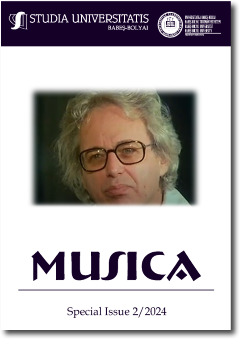Artistic Practices in the Context of the Evolution from Web 1.0 to Web 3.0
DOI:
https://doi.org/10.24193/subbmusica.2024.spiss2.08Keywords:
artistic practices, music, internet, technologies, interactivity, communicative models’ developmentAbstract
This article examines the evolution of artists’ interaction with the audience in the context of media culture, linked to the updates of communication mechanisms on the Internet, from the static Web 1.0 to the interactive Web 3.0. The aim of the article is to show the connections between the changes in authorship models and mechanisms of interaction with the audience in artistic practice and the evolutionary development of web technologies. The transformation of contemporary artistic forms is the result of the active influence of digital technologies and the associated collapse of the existing hierarchy between author, performer and audience. The study discusses the strengthening of the interactive component in artistic practices, parallel to the development of Internet technologies from Web 1.0 to the semantic Web 3.0 and analyzes the overlapping of these processes and their mutual influence in the context of post humanist perspectives. It was found that artistic collaborations through collective authorship are a characteristic model of authorship for this phase of Internet development. It was noted that the evolution from Web 2.0 to Web 3.0 opens new possibilities for the creation of multisensory experiences, thanks to the use of VR (Virtual Reality) and AR (Augmented Reality) technologies, which are actively used by artists in artistic practices and works, for example in operas or concerts. In addition, the active development and integration of artificial intelligence technologies in artistic practices has been identified. By analyzing musical projects of different genres and forms, the transformative influence of web culture on contemporary artistic practices becomes clear.
References
Ferrando, F. (2019). Philosophical posthumanism. London: Bloomsbury Academic. MTG - Music Technology Group (UPF). URL: https://mtg.upf.edu/files/publications/FMOLDexa.pdf. (дата звернення: 30.01.2024).
Hashmi, J. (2023, August 7). The Journey from Web 1.0 to Web 3.0. LinkedIn: Log In or Sign Up. https://www.linkedin.com/pulse/journey-from-web-10-30-junaid-hashmi.
Hayles, N. Katherine. (1999) How we became posthuman: virtual bodies in cybernetics, literature, and informatics / N. Katherine Hayles. 364 p.
How Artists can Embrace Web 3.0 — Sarah Ransome Art. (n.d.). SARAH RANSOME ART. https://www.sarahransomeart.com/blog/how-artists-can-embrace-web-3.
How can Artists Harness the Power of NFTs (Non-Fungible Tokens) — Sarah Ransome Art. (n.d.). SARAH RANSOME ART. https://www.sarahransomeart.com/blog/unlocking-the-world-of-nfts-a-comprehensive-guide-for-artists.
Logan, R. (2016). Understanding New Media (1st ed.). Peter Lang. Retrieved from https://www.perlego.com/book/1991551/understanding-new-media-pdf (Original work published 2016).
Luma. Miranda: A Steampunk VR Opera | September 25th 9:00pm EST LIVE Showing, 2020. YouTube. URL: https://www.youtube.com/watch?v=kjW3k9nDbcA. (date of access: 30.01.2024).
Marr, B. (2022, August 19). Web3, NFTs, And The Future Of Art. Forbes. https://www.forbes.com/sites/bernardmarr/2022/08/19/web3-nfts-and-the-future-of-art/?sh=2ce59d4c1e05.
McLuhan, M. (1994). Understanding Media: The Extensions of Man. The MIT Press.
Nath, K., Dhar, S. and Basishtha, S. “Web 1.0 to Web 3.0 - Evolution of the Web and its various challenges,” 2014 International Conference on Reliability Optimization and Information Technology (ICROIT), Faridabad, India, 2014, pp. 86-89, doi: 10.1109/ICROIT.2014.6798297
Schubert, Alexander. Alexander Schubert - Convergence [Ensemble Resonanz] @Kampnagel/Eclat, 2021. YouTube. URL: https://www.youtube.com/watch?v=o5UXkJWJciQ (date of access: 30.01.2024).
Serafin, S., Erkut, C., Kojs, J., Nilsson, N. C., & Nordahl, R. (2016). Virtual Reality Musical Instruments: State of the Art, Design Principles, and Future Directions. Computer Music Journal, 40(3), 22–40. https://www.jstor.org/stable/26777007.
Story of Convergence, ensemble resonanz. URL: https://www.ensembleresonanz.com/resonanz-digital/themen/story-of-convergence (date of access: 30.01.2024).
Team, T. I. (2021, November 15). Web 3.0 Explained, Plus the History of Web 1.0 and 2.0. Investopedia. https://www.investopedia.com/web-20-web-30-5208698.
Web3 in art: Implications for artists, art collectors, and the art industry. LeewayHertz - AI Development Company. URL: https://www.leewayhertz.com/web3-in-art/ (date of access: 30.01.2024).
Wiki-Piano.Net. Wiki-Piano.Net. URL: https://wiki-piano.net/ (date of access: 30.01.2024).
Downloads
Published
How to Cite
Issue
Section
License
Copyright (c) 2024 Studia Universitatis Babeș-Bolyai Musica

This work is licensed under a Creative Commons Attribution-NonCommercial-NoDerivatives 4.0 International License.






